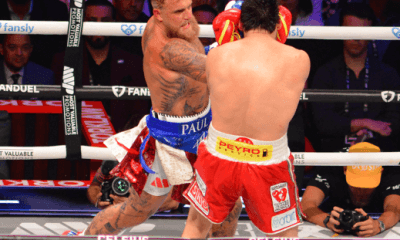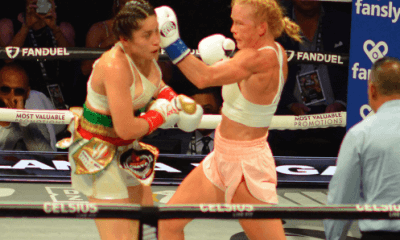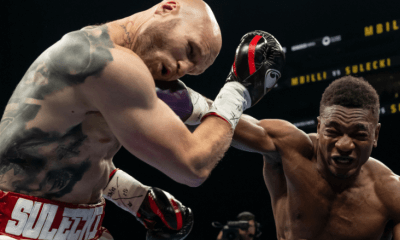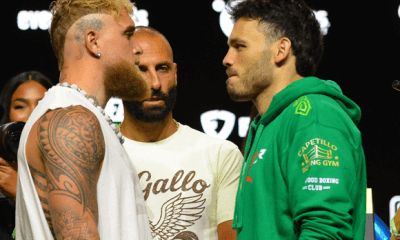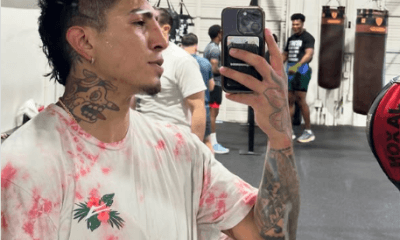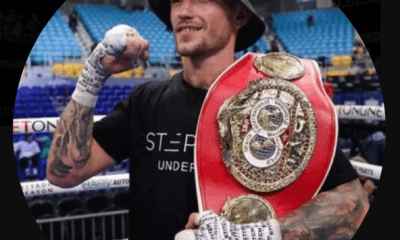Featured Articles
Introducing Jaylan Phillips, Boxing’s Palindrome Man
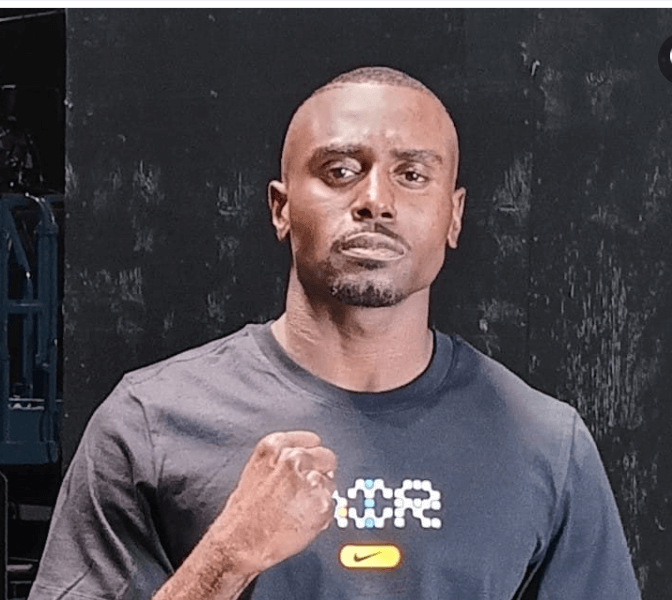
On Thursday, Nov. 28, as Americans hunkered down at the dinner table with family and friends for our annual Thanksgiving Day feast, junior welterweight Jaylan Phillips and his trainer Kevin Henry were up in the sky flying from Las Vegas to Rochester, New York. For their Thanksgiving repast, they were offered a tiny bag of peanuts.
Phillips would not have eaten too much had the opportunity presented itself. The next day was the weigh-in. On Saturday, the 30th, he would compete in the 6-round main event of a small club show.
Phillips wasn’t brought to Rochester to win. His opponent, Wilfredo Flores, had a checkered career but he had once held a regional title and he lived in the general area. In boxing parlance, Jaylan Phillips was the “B” side. His role, from the promoter’s standpoint, was to fatten the record of the house fighter.
Jaylan didn’t follow the script. He won a unanimous decision over his 11-3-1 opponent, advancing his record to 4-3-4, and returned to Las Vegas with a new nickname, albeit not one of his own choosing or intended as a permanent accessory. This reporter dubbed him The Palindrome Man.
A palindrome is a word that spells the same backward and forward. Phillips’ current record is palindrome-ish.
It’s an odd record. One would be hard-pressed to find other active boxers with a slew of draws inside a small window of fights. It harks to the days, circa 1900, when some journeymen boxers accumulated as many draws as wins and losses combined.
A boxer with a 4-3-4 record would seem to be an unlikely candidate for a feature story, but the affable Jaylan Phillips is not your run-of-the-mill prizefighter.
Boxers, as we know, tend to be city folk, drawn from the black belts and the barrios of America’s urban places. Phillips grew up in Ebro, Florida, population 237 per the 2020 U.S. census. Ebro is in the Florida panhandle in the northwestern part of the state in a county that was dry until 2022. It is 23 miles due north of Panama City Beach but a world apart from the seaside Florida resort town and its pricey beachfront condos.
Of those 237 people, only five identified as African-American or black, or so it would be written, but the census-taker was obviously slothful. “That’s a crazy number,” says Phillips. “There has to be at least 40 or 50. And the reason I know that is that we are all related.”
“What does one do for excitement in Ebro?” we asked him. “Hunting, fishing, trapping, that sort of thing,” he said. And what does one trap? “Mostly raccoons,” he said, while adding that some of the elders in his extended family consider it a delicacy.
Phillips fought in Rochester, New York, on Saturday and was back in the gym in Las Vegas on Tuesday. He lives alone and does not own a car. His apartment, near UNLV, is three-and-a-half miles from the Top Rank Gym where he does most of his training. He jogs there and then jogs home again, this in a city where the temperature routinely exceeds 100 degrees for much of the year.
During his high school years, Phillips, now 25, concedes that he smoked a lot of weed and it impacted his grades. His interest in boxing was fueled by the exploits of Roy Jones Jr, another fighter with roots in the Florida panhandle. In his spare time, he enjoys watching tapes of old Sugar Ray Robinson fights which can be found on youtube. “He was the best,” says Phillips of Robinson who has been dead for 35 years, echoing an opinion that hasn’t diminished with the passage of time.
In his second pro fight, Phillips was thrust against a baby-faced novice from Cleveland, Abdullah Mason. Although Mason was only 17 years old, the Top Rank matchmaker did Jaylan no favors. He was still standing when the referee waived the fight off in the second round.
About the heavily-hyped Mason, Phillips says, “He’s a beast, like they say, but I would love to fight him again. I took that fight on two weeks’ notice. I’m confident the outcome would have been different if I had had a full camp.”
This observation will undoubtedly strike some as a delusion. Pound for pound, the precocious Mason just may be the top pro fighter in the world in his age group. But Jaylan isn’t lacking confidence which spills over when he talks about what lies ahead for him. “I will be a world champion,” he says matter-of-factly. And after boxing? “I see myself back home in Ebro living a humble life, hunting and fishing, but with a million dollars in the bank.”
If unswerving dedication and self-confidence are the keys to a successful boxing career, then Jaylan Phillips, notwithstanding his 4-3-4 record, is destined for big things. But here’s the rub:
“In boxing, it isn’t what you earn, but what you negotiate,” says the esteemed British boxing pundit Steve Bunce alluding to the importance of a well-connected manager. In a perfect world, each win would be stepping-stone to a bigger fight with a commensurately larger purse. But in this chaotic sport, a “B side” fighter who scores an upset in a low-level fight may actually be penalized for his “impertinence.” Promoters may be wary of using him again (the old “risk/reward” encumbrance) and, in a sport where it’s important for an up-and-comer to stay busy, his progress may be stalled.
Phillips doesn’t know when his next assignment will materialize, but regardless he will keep plugging along while setting an example that others who aspire to greatness would be wise to emulate.
To comment on this story in the Fight Forum CLICK HERE
-
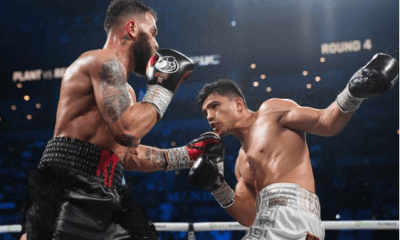
 Featured Articles4 weeks ago
Featured Articles4 weeks agoA Night of Mismatches Turns Topsy-Turvy at Mandalay Bay; Resendiz Shocks Plant
-

 Featured Articles2 weeks ago
Featured Articles2 weeks agoAvila Perspective, Chap. 330: Matchroom in New York plus the Latest on Canelo-Crawford
-
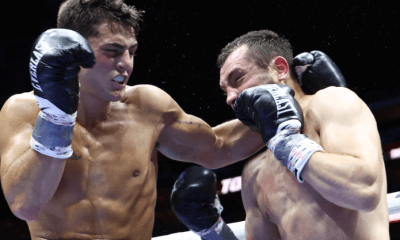
 Featured Articles1 week ago
Featured Articles1 week agoVito Mielnicki Jr Whitewashes Kamil Gardzielik Before the Home Folks in Newark
-
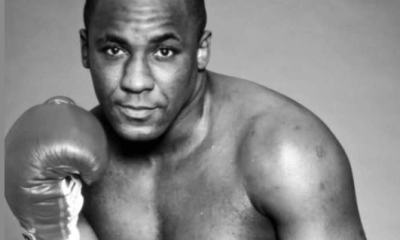
 Featured Articles4 weeks ago
Featured Articles4 weeks agoRemembering the Under-Appreciated “Body Snatcher” Mike McCallum, a Consummate Pro
-
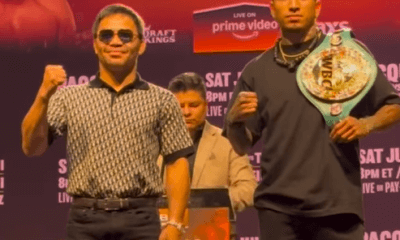
 Featured Articles4 weeks ago
Featured Articles4 weeks agoAvila Perspective, Chap 329: Pacquiao is Back, Fabio in England and More
-
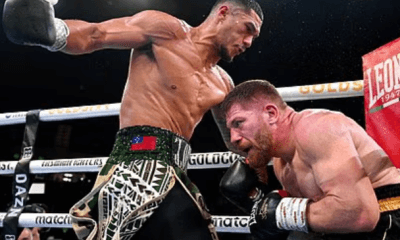
 Featured Articles3 weeks ago
Featured Articles3 weeks agoOpetaia and Nakatani Crush Overmatched Foes, Capping Off a Wild Boxing Weekend
-

 Featured Articles3 weeks ago
Featured Articles3 weeks agoFabio Wardley Comes from Behind to KO Justis Huni
-
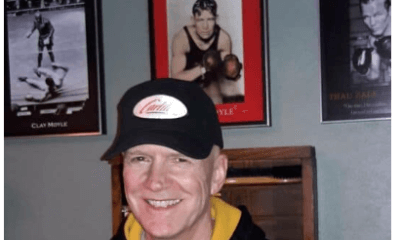
 Featured Articles2 weeks ago
Featured Articles2 weeks agoCatching Up with Clay Moyle Who Talks About His Massive Collection of Boxing Books

